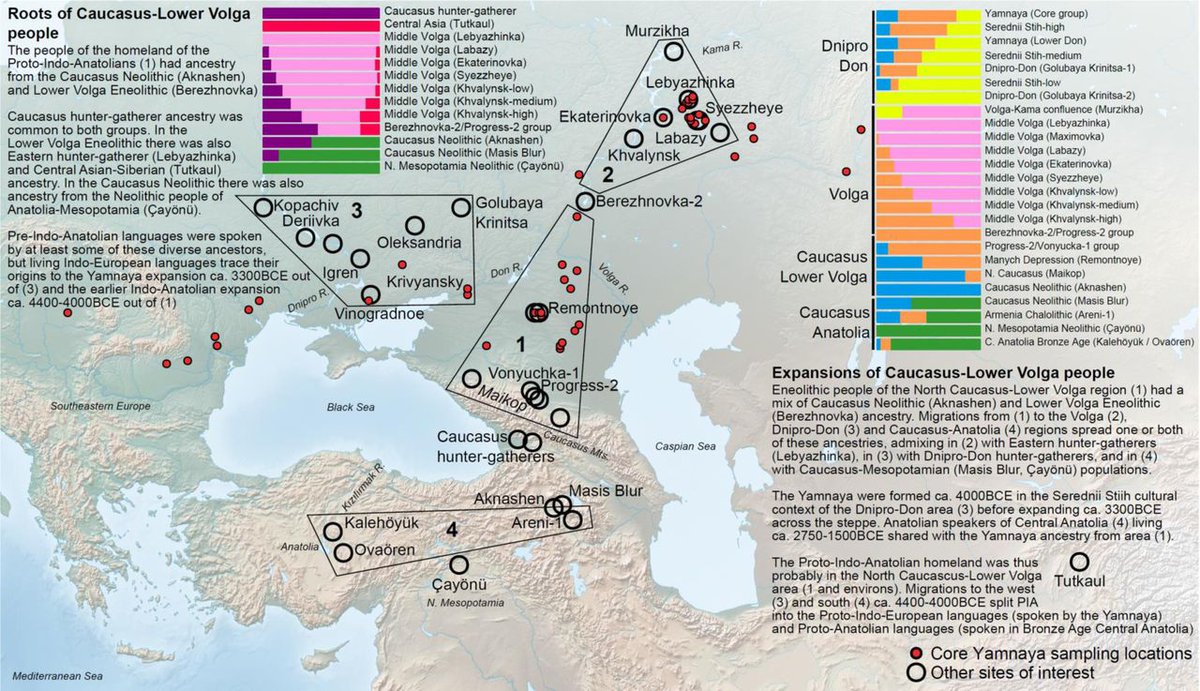
Research Associate @harvardheb and @hmsgenetics studying history with ancient DNA.
How to get URL link on X (Twitter) App


 (1) Christian denominations inquiry
(1) Christian denominations inquiry


 In two other screenshots (by X users), see the never-ending debate (in online platforms, at least) whether Jews are white or not. The same West Eurasian PCA, different arbitrary definitions of "white" or "non-white" 2/
In two other screenshots (by X users), see the never-ending debate (in online platforms, at least) whether Jews are white or not. The same West Eurasian PCA, different arbitrary definitions of "white" or "non-white" 2/ 


 Next the Maikop (the North Caucasus end of the CLV cline; the South Caucasus end at Aknashen in Armenia can't be plotted as it is a single individual).
Next the Maikop (the North Caucasus end of the CLV cline; the South Caucasus end at Aknashen in Armenia can't be plotted as it is a single individual).

 "The genetic origin of the Indo-Europeans" describes our solution: a Caucasus-Lower Volga homeland of Proto-Indo-Anatolian speakers and a North Pontic (or Dnipro-Don) homeland of the Proto-Indo-Europeans which we identify as the Yamnaya. 2/
"The genetic origin of the Indo-Europeans" describes our solution: a Caucasus-Lower Volga homeland of Proto-Indo-Anatolian speakers and a North Pontic (or Dnipro-Don) homeland of the Proto-Indo-Europeans which we identify as the Yamnaya. 2/
 This hypothesis agrees (partly) with both two hypotheses of the Southern Arc paper. Recall that Hypothesis A is a steppe origin with massive dilution and Hypothesis B is an eastern origin from the broad area denoted by the Proto-Indo-Anatolian circle of that paper.
This hypothesis agrees (partly) with both two hypotheses of the Southern Arc paper. Recall that Hypothesis A is a steppe origin with massive dilution and Hypothesis B is an eastern origin from the broad area denoted by the Proto-Indo-Anatolian circle of that paper. 

https://twitter.com/Tom_Rowsell/status/1767140767334539427The population of the Roman Republic was not simply "native Italians" but had already received migrants from the east -in accord with the writings of ancient Greek and Roman historians. This can be seen, e.g., in Fig. 3A,C below:




 There are many interesting findings, but I will highlight a few:
There are many interesting findings, but I will highlight a few:
 The central paper develops the joint analysis framework of the entire dataset, and focuses on the ~5000-1000 BCE period and our theory of a West Asian Indo-Anatolian homeland out of which came both Anatolian speakers and steppe Proto-Indo-Europeans
The central paper develops the joint analysis framework of the entire dataset, and focuses on the ~5000-1000 BCE period and our theory of a West Asian Indo-Anatolian homeland out of which came both Anatolian speakers and steppe Proto-Indo-Europeans
 The importance of this paper cannot be understated. Previously, it was thought that modern humans may have only made occasional forays Out-of-Africa in the >100,000 year time frame into the Levant, in sites such as Shkul/Qafzeh and as early as ~180,000 years ago in Misliya
The importance of this paper cannot be understated. Previously, it was thought that modern humans may have only made occasional forays Out-of-Africa in the >100,000 year time frame into the Levant, in sites such as Shkul/Qafzeh and as early as ~180,000 years ago in Misliya